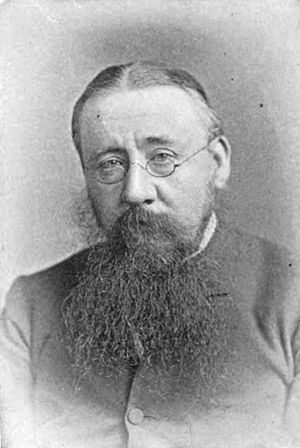George Saintsbury facts for kids
Quick facts for kids
George Saintsbury
|
|
|---|---|

Photograph by James Lafayette (c. 1910)
|
|
| Born | 23 October 1845 Southampton, England |
| Died | 28 January 1933 (aged 87) Bath, Somerset, England |
| Occupation | Critic, literary historian, editor |
| Alma mater |
|
| Genre | Literary criticism |
| Signature | |
George Edward Bateman Saintsbury (born October 23, 1845 – died January 28, 1933) was an important English writer. He was a critic, someone who judges and explains books. He was also a literary historian, meaning he studied the history of literature. Besides that, he was an editor, a teacher, and someone who really appreciated wine. Many people think he was a very important critic in the late 1800s and early 1900s.
About George Saintsbury
George Saintsbury was born in Southampton, England. He went to school at King's College School in London. Later, he studied at Merton College, Oxford, a famous university. He did very well in his studies, especially in classical subjects.
After university, in 1868, he became a teacher. He taught at Manchester Grammar School for a short time. Then, he spent six years in Guernsey as a senior classical master at Elizabeth College, Guernsey. This is where he started his writing career. He began writing reviews for a magazine called The Academy.
From 1874 to 1876, he was the headmaster of the Elgin Educational Institute. He also worked for The Manchester Guardian newspaper for a short time in 1877. In the 1880s and early 1890s, he worked as a writer and editor for the Saturday Review. He collected some of his writings from these magazines into books like Essays in English Literature and Essays on French Novelists.
In 1895, Saintsbury became a professor at the University of Edinburgh. He taught about writing and English literature until 1915. After he retired, he kept writing. He lived in Bath, Somerset. He passed away in 1933 when he was 87 years old.
His Work as a Critic
George Saintsbury wrote many books about literature. His first book, A Primer of French Literature (1880), was about French writing. He also wrote a Short History of French Literature (1882). These books made him a leading expert on French literature in England.
He also studied English literature a lot. He helped update an edition of John Dryden's Works. He wrote books like History of Elizabethan Literature (1887) and History of Nineteenth Century Literature (1896). His book A Short History of English Literature (1898) was very popular and was reprinted for many years.
Saintsbury also edited collections of old poems. He even created the word "Janeite" for fans of the author Jane Austen. He used this term in his introduction to an 1894 edition of Pride and Prejudice.
He wrote many articles for the Encyclopædia Britannica, a large encyclopedia. These articles covered famous writers like Pierre Corneille and Voltaire.
In the early 1900s, Saintsbury edited an English version of Honoré de Balzac's novel series La Comédie humaine. He also edited a series of books called Periods of European Literature.
Some of his most important works came out later. These included A History of Criticism (1900–1904), which looked at how people have judged literature over time. He also wrote A History of English Prosody (1906–1910), which is about the rhythm and patterns of English poetry. Other works include The English Novel (1913) and A History of the French Novel (1917–1919).
In 1925, he helped publish a very old recipe book by Anne Blencoe. This book had been lost for 200 years!
His Love for Wine
Even though Saintsbury was famous for his writing, he is also remembered for his book Notes on a Cellar-Book (1920). This book is a famous collection of thoughts about wine and enjoying drinks.
After his death, a group called the Saintsbury Club was formed. It's made up of writers and people from the wine business. They still meet today to enjoy dinners and discuss literature and wine.
Legacy
The famous poet T.S. Eliot dedicated his book Homage to John Dryden (1924) to George Saintsbury. This shows how much Eliot respected Saintsbury's work.
Saintsbury lived at 1A Royal Crescent in Bath, Somerset from 1915 until he died. This building was once the servants' quarters of a larger house. In 2012, it was restored and opened to visitors in 2013. In 2014, an exhibition celebrating Saintsbury's life was held there.
A book about Saintsbury's life and writings, written by Dorothy Richardson Jones, was published in 1992.


